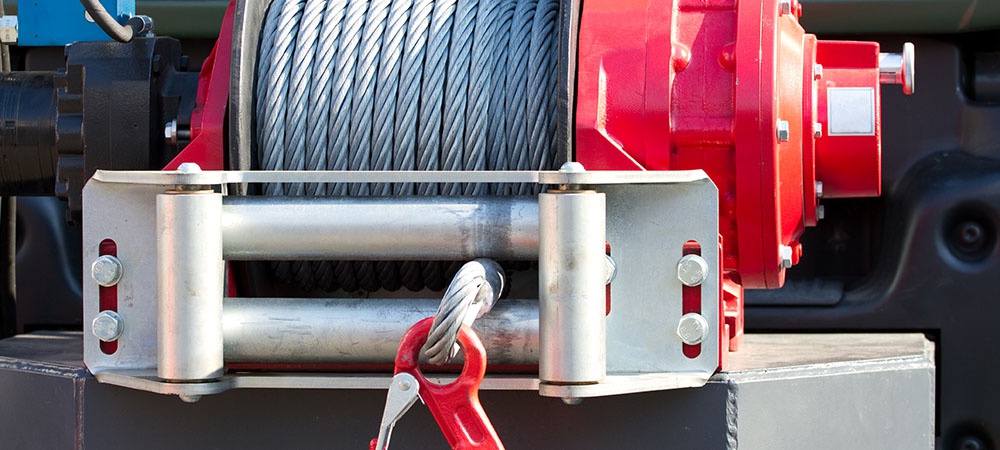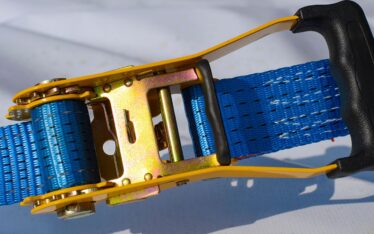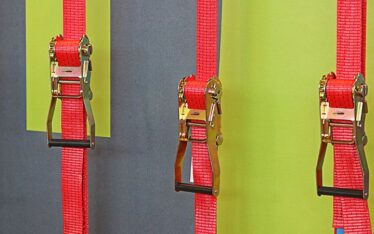Winch straps are woven ropes and metal hooks that attach to boats, trucks, or trailers for towing reasons. Sometimes, they are used to tow other vehicles. Different weights are used for various objects. But generally, select a winch with a capacity of 1.5 times the item you wish to pull.
These ropes are popular in the trucking industry because they are more cost-effective than traditional alternatives like ratchet straps. Besides, they can tie down very heavy and oddly shaped loads on the road. Installing these straps is easy and faster, enabling them to create a versatile and durable load securement necessary for heavy-duty cargo.
The polyester bands come in different sizes, the most popular sizes being the 2-inch and 4-inch-wide straps. Polyester is a preferred material because it has a very high strength-to-stretch ratio that effectively secures your load.
Additionally, these ropes don’t require any tie-down hardware to tighten them into place. Averagely, flatbed truck drivers replace these straps every three months. This replacement is necessary because of repetitive usage and excessive tension that exposes them to weakening friction and sharp ages. Additionally, exposure to the sun and saltwater weakens the bands.
So, how do you replace a deteriorating winch strap? Answering this question brings us to our post’s theme: how to install a winch strap. Keep reading to learn how to install your winch band.
1. Buy the Correct Strap
Start your replacement process by purchasing the correct size of strap. These bands come in different widths, mostly 2’’ and 3’’, depending on trailer length and load capacities. So, choose a model with a maximum breaking load of at least 20% greater than your cargo’s weight.
Ensure the strap isn’t too short or long because it won’t fit in the groove provided for this purpose. The rope has its workload capacity written on it. So, read it or refer to its manufacturer’s manual when unsure.
2. Remove the Old Winch Strap
Second, unroll your old strap all the way. Do it carefully, or else your fingers might be caught.
3. Loosen the Central Bolt
A central bolt holds the strap in place. Therefore, loosen the bolt’s nuts with two keys. Initially, removing the old strap’s nuts might be difficult because of rust or corrosion. In this case, you can use a professional tool to unscrew such nuts.
4. Unscrew and Check the Central Bolt
After unscrewing the bolt, remove it from the winch and detach the rope. If the strap is too old, you may remove it by cutting it. Next, inspect its condition to ascertain if it’s too old, twisted, or corroded for reuse. If it isn’t reusable, change it.
5. Clean It
After removing the bold, clean the winch cage and ensure it doesn’t have corrosion. You may need to spray some cold galvanizing if the coating is a bit damaged. Repeat the same process for its center bolt.
6. Install the Hook
Next, it’s time to install the hook. Most straps come with new hooks. Install the hook by keeping the belt flat.
7. Fit the New Strap
Now, fit the bolt into the new strap into the winch cage and slide the bolt into the loop sewn at the strap’s end. Tighten the central nuts’ bolt without over tightening it because you need the axis to remain mobile.
8. Wind the New Winch Strap
Next, wind your new band onto the winch drum using the crank. Be careful to thread the strap neatly by keeping it flat without wrinkling it.
9. Lightly Grease the Winch
Lastly, spray a little lubricant on the winch’s mechanical part for easier handling.

Tips for Installing and Using Winch Straps
Do you want to get the most out of your winch strap? Here are tips to help you do so.
- Routinely Clean Your Straps
Gradually, your winch’s hooks gather mud or small debris, making them difficult to use. Routine cleaning ensures that your straps keep functioning efficiently for a longer time. Additionally, regular cleaning keeps them in excellent shape.
- Remove Your Winch Straps When Not in Use
Proper strap storage prolongs their life. You must wrap and store your straps in a dry place like a toolbox. Securing your straps on the road with cargo securement tools gives you peace of mind. This way, your belts are protected against cutting or tearing while in transit.
- Check Your Winch Straps
Regarding cuts and tearing, check your straps before and after each tie-down. This check exposes any fraying sign, particularly when hauling sharp-edged cargo. We recommend you use chains instead of straps for heavy or sharp edges to protect them from fraying and cutting.
If your straps are fraying, it’s recommended you cut off the frayed edges and burn them to prevent unraveling or spreading. This way, your belts will last longer.
- Never Twist the Straps
You should never twist your straps while securing your loads. Why? Because gradually, they weaken the strap’s webbing and lower their overall lifespan. Further, twisting your ropes could damage or mark up fragile loads when the straps aren’t lying flat against them.
- Wrap Excess Straps
Lastly, wrap up any excess strap before you drive off. You can wrap the straps using Velcro or zip ties because they are cheap and easy to use. This step is beneficial, especially when traveling down busy highways or driving at high speeds.

Contact Us for All Your Shipping Needs
Installing winch straps correctly is one way of securing your cargo during transit. Our post shared valuable insights to help you install these straps for efficient use. We also shared practical tips to help you use them optimally.
Do you need more help with your logistical needs but don’t know a suitable partner to sort you out? Don’t look any further when we are here to assist you. Our doors are open and ready to let you into our exciting world of excellent logistic solutions. Go ahead and contact our team today for a free quote and consultation.



